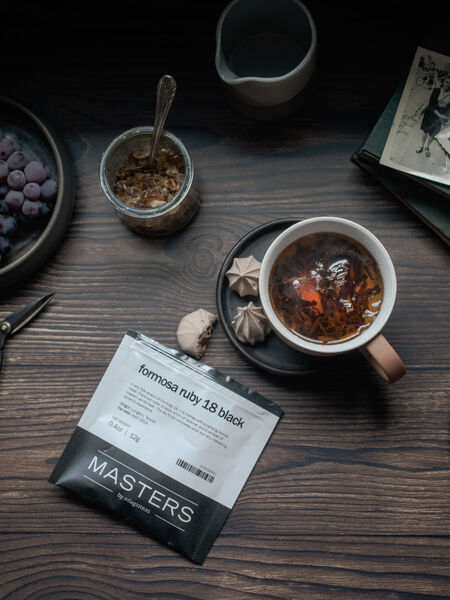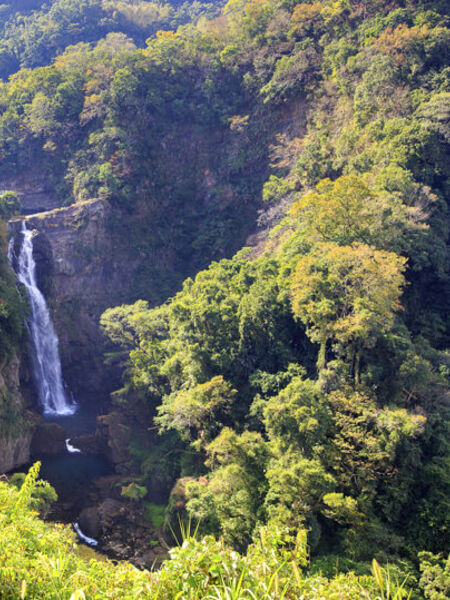Taiwan Ruby 18 Black Tea: Rich and Complex


Overview
Long Tan is a rural district within Taoyuan County and lies southwest of Taipei County. It has a notable history in black tea production. The township is known for the Buddhist temple in the center of Longtan Lake and the area is surrounded by high-tech industries and mountains. The tea industry in Longtan Taoyuan used to be extremely prosperous with hundreds of tea manufacturers operating simultaneously within the district. Sadly however, that industry has continuously collapsed and there are now only a few remaining.
Fuyuan Tea Factory
However you can still visit Fuyuan Tea Factory, a 90 year old tea factory located in Hakka village in Taoyuan. Visitors can learn about tea processing here and enjoy many experiences including the picking, shaping, and panning of tea. You can even get hands on making tea powder! The tea factory produces green tea, black tea and oolong. On the ancient road that leads to Fuyuan Tea Factory, tea hills and fields where the tea pickers work diligently create a picturesque view. The founder of Fuyuan Tea Manufactory built it using only the local materials available and worked endlessly to introduce mass production using European machineries which are still operating today after all those years.
Famous landmarks in the area also include Longtan Tourist Pond, water slide, riverbank trail, and Yongyi Bridge, all offering a relaxing environment surrounded by water. From Rugu Mountain which stands at 390m high, you can overlook Guanyin, Zhongli and Linkou and even Taipei 101, enjoying the incredible view highlighted beautifully by the lights of the city. There are so many great spots to take your tea outdoors which would be a great way to experience the tea's terroir.
Formosa Ruby 18 Black
The tea that we currently stock from this area of Taiwan is our Formosa Ruby 18 Black. A very fine version of the Ruby 18, otherwise known as Red Jade, it is intense with surprising licorice notes. The long, dark leggy leaves contain some lovely buds. With both its aroma and taste, this tea has notes of milk chocolate, woods, cream, black licorice, cinnamon, toasted vanilla bean, caramel and camphor, tobacco, smoke, toasted sesame seeds and much more. The dry finish completes what is a very interesting, dynamic experience. In a word, excellent.
Ruby #18 is a unique cultivar from Taiwan, and a relatively new invention. Ruby #18 was developed by the Taiwanese Tea Research people (TTRES). They started development in 1962 but only completed it in 1999 by cross breeding the Taiwanese Chin Xin leaf with the Assam leaf. It is a hybrid between a native variety and Var. Assamica from Burma, a cross between a wild Formosa tea plant and an Assam from Burma. Unsurprisingly Ruby #18 is one of the most popular black teas in Taiwan and the rest of East Asia and is a favorite of many a tea lover around the world.
This tea is grown at an elevation of 400m. While you wouldn't normally expect to see oolong from Taiwan grown at a much higher elevation, many farms at lower elevation levels have begun to develop over the last decade. They became a more popular choice due to the fact that farmers are able to produce a larger yield per area ratio due to flatter ground where machine harvesting is possible at a lower elevation where the tea plants tend to grow faster.
Bao Zhu Fan
Farmer - Bao Zhu Fan’s family was in tea production, but she didn’t really know about tea until she married her husband. His family has been making tea for over 100 years, and she has now been helping them for almost 30 years. She puts lots of hard work into the tea, with her days starting in the tea gardens at around 7am and not ending until 6pm. Sometimes she even has to go back and continue working, often well into the night. Bao Zhu Fan says that plucking tea is both her favorite part of her job but also the hardest part of it. It is her favorite part because she feels happy when she sees the big leaves as it’s a sign to her that the plants are growing well. However it is also the hardest part of the job because you have to stay in the sunshine throughout the day and many of the plucking workers are getting old and it's difficult to find young workers to increase work efficiency.
How to Prepare
When asked how best to prepare Formosa Ruby 18 Black, farmer Bao Zhu Fan said that this tea does not need to be put into water for a long time, the best flavor and aroma come from the light liquid. However this tea can be prepared in a number of ways and is incredibly forgiving. Should you be in a rush but still want some tea to sip on, this tea steeps perfectly well western style. Should you have a little more time to set aside to experience this tea it really thrives when prepared gongfu style in both clay and porcelain and you’ll also get a lot more steps out of it when preparing gongfu style as well. Should you want to try out something new when sitting down to do a session with this tea, give grandpa style or bowl brewing a try. This is almost impossible to mess up so you can brew it any way you want to, it's all about finding out what works best for you.
If you are choosing to prepare this gongfu style you’ll want to use 4-4.5g of tea per 3.3floz of water, boil your water and let it cool to between 203-208F and start your steeps at ten seconds, adding 5 seconds on for each steep. Following these parameters you will be able to get at least 8 steeps out of your leaves. If you are choosing to steep this western style use 0.7-0.8g of leaf per 3.3floz of water. Steep one should last 120 secs and for each steep after that you should add 60 secs to your steeping time. Using these parameters you’ll be able to get at least 4 steeps out of your leaves.
We hope this post has helped you learn something new! Keep your eyes on the blog over the next few months for the next few posts within this series focusing on different tea growing districts within Taiwan and the teas that they are famous for.
